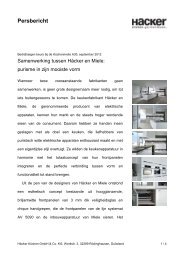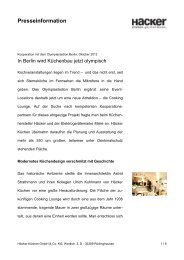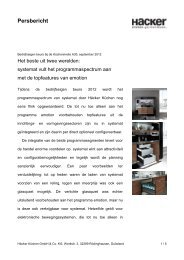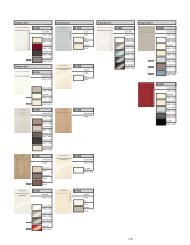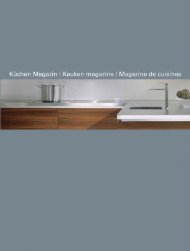Pflege- und Bedienungsanleitung
Pflege- und Bedienungsanleitung
Pflege- und Bedienungsanleitung
You also want an ePaper? Increase the reach of your titles
YUMPU automatically turns print PDFs into web optimized ePapers that Google loves.
GB<br />
Instructions for care and use<br />
Glass doors<br />
Since glass is a pore-free material, it is ideal<br />
for use in the kitchen, not only for reasons of<br />
hygiene. Clear glass can be cleaned with a<br />
mild detergent or any standard household<br />
glass cleaning agent. Chemicals and highly<br />
caustic agents should immediately be<br />
removed with water to protect the glass<br />
surface. Abrasive action or scratching also<br />
impair the glass surface.<br />
Satinated glass generally has a slightly<br />
rougher surface than clear glass. It can easily<br />
be cleaned with a cloth or sponge and<br />
standard household glass cleaning agent.<br />
The glass surface should not be exposed to<br />
cleaning agents containing silicone or acid.<br />
Greasy and oily substances produce stains<br />
with a slight shadowy effect on satinated<br />
glass, but they can easily be removed with<br />
a glass cleaning agent.<br />
18<br />
Hardened glass is an extremely robust<br />
material, but not unbreakable. Overloading,<br />
for instance if the edges and/or surface are<br />
damaged, will destroy the stress balance in<br />
the glass, causing it to shatter spontaneously.<br />
This shattering may occur immediately or<br />
some time after the glass was overloaded.<br />
Hard knocks and bumps on the glass<br />
should therefore be avoided.<br />
Glass is made of natural raw materials. Slight<br />
variations in colour therefore cannot be<br />
excluded.<br />
E<br />
Consejos de cuidado y utilización<br />
Puertas de cristal<br />
Como el cristal es un material sin poros,<br />
resulta especialmente apropiado para la<br />
cocina desde el punto de vista higiénico. El<br />
cristal transparente se puede limpiar con<br />
productos de limpieza suaves así como con<br />
limpiacristales de uso doméstico. Los<br />
productos químicos o los medios muy<br />
abrasivos se deberían eliminar<br />
inmediatamente con agua para proteger la<br />
superficie del cristal. Los roces o arañazos<br />
también dañan la superficie del cristal.<br />
A diferencia del cristal transparente, el cristal<br />
satinado tiene una superficie ligeramente<br />
áspera que también puede limpiarse<br />
perfectamente con un paño o esponja y<br />
limpiacristales de uso doméstico. La<br />
superficie de cristal no se debería tratar con<br />
productos de limpieza que contengan silicona<br />
o ácido.<br />
Las sustancias grasientas o aceitosas generan<br />
manchas con un ligero efecto de sombra en<br />
las superficies satinadas. Sin embargo, estas<br />
manchas se pueden eliminar fácilmente con<br />
un limpiacristales.<br />
El cristal endurecido es un material muy<br />
robusto, aunque no irrompible. En caso de<br />
sobrecarga, debida por ejemplo a deterioros<br />
en los cantos y/o en la superficie, se<br />
destruye el equilibrio de tensiones del cristal,<br />
lo cual provoca la rotura espontánea del<br />
mismo. Dicha rotura puede producirse<br />
inmediatamente o poco tiempo después de<br />
producirse la sobrecarga. Por este motivo<br />
deberían evitar los golpes o sacudidas de la<br />
frente de cristal.<br />
Para la fabricación de cristal se emplean<br />
materias primas naturales, por lo que pueden<br />
producirse ligeras diferencias de color.



